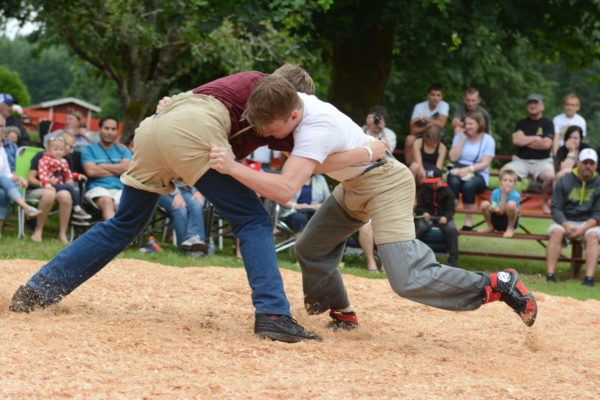 It’s probably more complicated than this, but the basic strategy of Swiss wrestling seems to be to grab your opponent by the pants and tip him over before he tips you over.
It’s probably more complicated than this, but the basic strategy of Swiss wrestling seems to be to grab your opponent by the pants and tip him over before he tips you over.
If this is something you would like to try, or to watch, make sure that next year on the closest weekend to the Fourth of July, you’re in Frances — a small town along Highway 6 in Pacific County — for Schwingfest, a three-day celebration of all things Swiss.
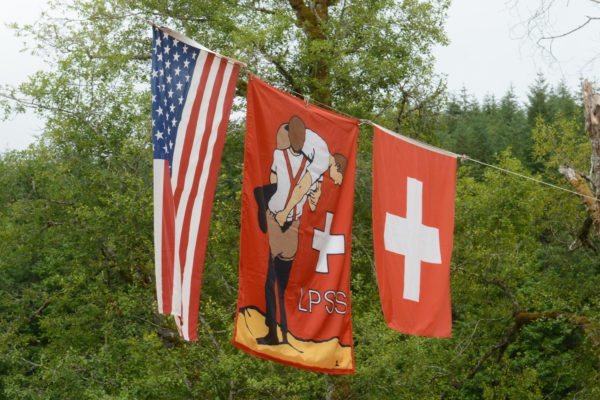 The Lewis-Pacific Swiss Society, with roots in the dairy farming families of Lewis and Pacific counties, has been throwing a Schwingfest since 1964 and the organization itself goes back to 1929. Schwingfest is a social event and wrestling competition with the feel of a family reunion. It brings together people from various Swiss societies around the region and lots of people who live in the area or who once lived in the area and come back for Schwingfest. There’s beer, bratwurst, music, dancing and the crowning of a Swiss Miss, but make no mistake, schwingen – Swiss wrestling — takes center stage.
The Lewis-Pacific Swiss Society, with roots in the dairy farming families of Lewis and Pacific counties, has been throwing a Schwingfest since 1964 and the organization itself goes back to 1929. Schwingfest is a social event and wrestling competition with the feel of a family reunion. It brings together people from various Swiss societies around the region and lots of people who live in the area or who once lived in the area and come back for Schwingfest. There’s beer, bratwurst, music, dancing and the crowning of a Swiss Miss, but make no mistake, schwingen – Swiss wrestling — takes center stage.
It’s said to be the national sport of Switzerland and may go back as far as the Middle Ages, and at least as far back as the 1600s.
It goes like this: The contestants wear loose fitting, heavy canvas-type shorts — called Schwingerhosen — over their clothes. They’re held up by a leather belt (the shorts, not the contestants). The contestants come together in the center of a sawdust covered ring and lean in shoulder to shoulder, each reaching around to grab the other’s belt with one hand and get a good grip on the bottom hem of their opponent’s shorts with the other. After that it’s about strength, leverage, quickness, size, stamina and experience.
There is a referee in the ring and three judges sitting near the edge of it in a little hut that looks like it would be at home in the Alps. They award points to the winner and loser. And after the match, tradition calls for the winner to brush the sawdust off the shoulders of his opponent as they leave the ring.Wrestlers win by pinning the opponent’s shoulders. If the shoulders are pinned flat as result of a standing move the winner gets 10. If ground work is required to roll them over then the winner is awarded 9.75. If time runs out, it is a tie and both get 9. Losers get 8.75.
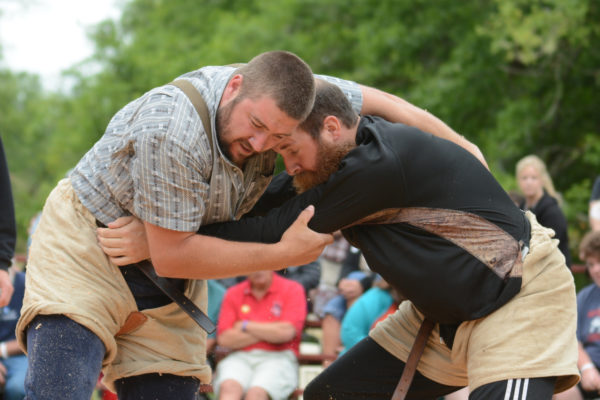 The bouts last five minutes (unless one guy pins the other) and every Schwinger wrestles six matches. It all takes at least half the day, with a break around lunch time, when the grill opens and the brats and burgers are ready. (Wrestlers get a free lunch and a spot at the front of the line).
The bouts last five minutes (unless one guy pins the other) and every Schwinger wrestles six matches. It all takes at least half the day, with a break around lunch time, when the grill opens and the brats and burgers are ready. (Wrestlers get a free lunch and a spot at the front of the line).
Initially, the wrestlers are paired according to size and past performance. In later rounds, points are a bigger factor. After everyone has wrestled in one of the six rounds, they mix and match and assign opponents for the next round. Inevitably it means some mismatches in terms of size and ability, but the smaller wrestlers are amazingly adept at compensating.
A Schonschwinger, meaning “beautiful wrestler” is awarded in each age group, based on a combination of wrestling style, effort and sportsmanship. The winner is chosen by votes (in secret, because most voters don’t want any recognition) from five to 10 former wrestlers among the crowd, said Adrian Cook, vice president of the Lewis-Pacific Swiss Society.
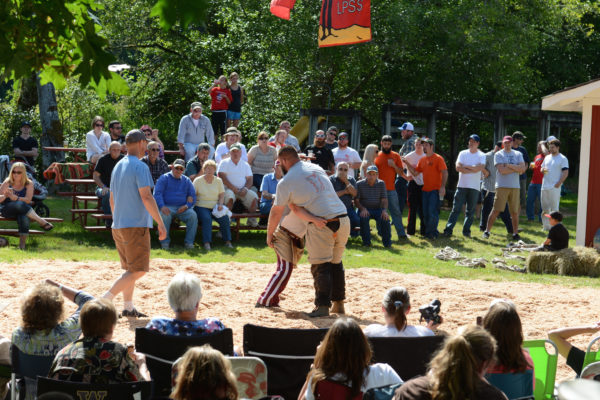 The events take place at Swiss Park in Frances, along the Willapa River at a campground owned by the Swiss Society. The park has lots of space for RVs and many of the rigs are sporting Swiss flags. Wrestlers and Schwingfest fans come from as far away as California, said Cook.
The events take place at Swiss Park in Frances, along the Willapa River at a campground owned by the Swiss Society. The park has lots of space for RVs and many of the rigs are sporting Swiss flags. Wrestlers and Schwingfest fans come from as far away as California, said Cook.
There’s a community hall with a large kitchen. Meals are inexpensive and there are dances Friday and Saturday nights. Saturday night, the top wrestlers get traditional Swiss kronzes — an oakleaf headcrown — bells and money awarded by their chosen crown girl (usually with a kiss or a hug). The rest of the wrestlers also get money and prizes including travel pay for those coming from other clubs or Switzerland — and the Shonschwinger awards
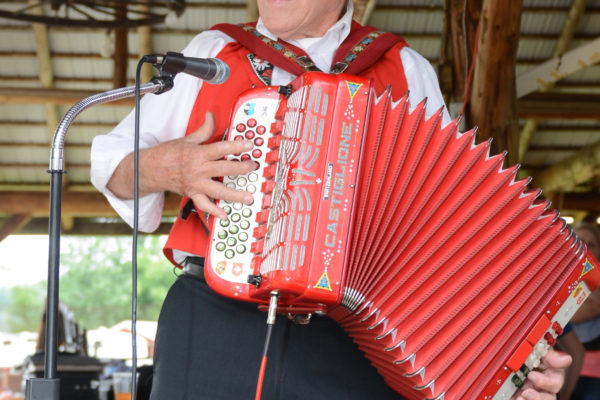 According to a history of the Society, Schwingfest evolved from what started in 1929 as a gathering of Swiss people — many of them dairy farmers and loggers — for a picnic, which took place on part of the property that is now part of Swiss Park. By 1931 they had formed a Swiss Society and built an open dance floor for the picnics. The picnics and dances continued and the organization grew in number and in terms of a facility and 1964, the group resolved to put on Schwingfest. There was some doubt that people in other Swiss societies would travel for their remote event and the men had to learn the rules of schwingen, but they took the leap. That was 52 Schwingfests ago.
According to a history of the Society, Schwingfest evolved from what started in 1929 as a gathering of Swiss people — many of them dairy farmers and loggers — for a picnic, which took place on part of the property that is now part of Swiss Park. By 1931 they had formed a Swiss Society and built an open dance floor for the picnics. The picnics and dances continued and the organization grew in number and in terms of a facility and 1964, the group resolved to put on Schwingfest. There was some doubt that people in other Swiss societies would travel for their remote event and the men had to learn the rules of schwingen, but they took the leap. That was 52 Schwingfests ago.
In an age where traditional groups and organizations are struggling to hang on, the participation for Schwingfest seems nothing short of remarkable. This year’s Frances event drew at least 20 adult (18 and over) wrestlers, down a bit, but enough for a full day of wrestling. The senior and junior schwingers, aged 15 through 17, wrestle on Saturday and the buebeschwingers split into three age groups between the ages of 6 and 12, wrestle Sunday after church. The young wrestlers outnumber the senior ones, which bodes well for the future of Schwingfest.
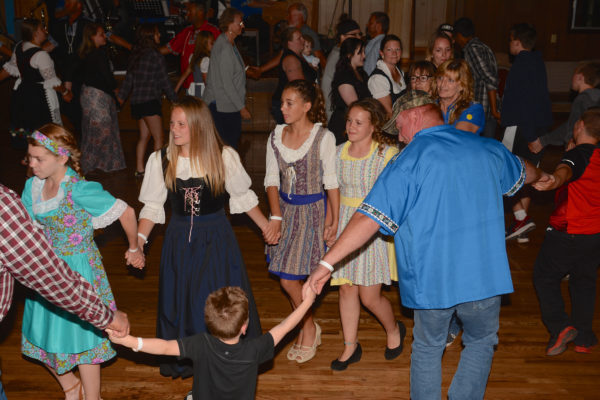 There’s no female competition, but both males and females compete in another event, called steinstossen. It’s pretty straight forward. There’s a big rock and people throw it as far as they can. You have to figure that the roots of this event go back a ways.
There’s no female competition, but both males and females compete in another event, called steinstossen. It’s pretty straight forward. There’s a big rock and people throw it as far as they can. You have to figure that the roots of this event go back a ways.
Cook said he thinks the stone weighs about 30 pounds. It’s painted to resemble a Swiss flag, bright red with a white cross.
The fact that the event continues to thrive isn’t something the organizers take for granted. “We want to make sure our kids understand the heritage and enjoy it. … This day and age, there are so many demands on their time, (video games), phones, sports. … Right now, we’re lucky and we want to keep it that way.”
“In 1941 a decision was made to have free beer at the annual meetings. One of the ladies suggested that since the men were getting free beer and the children were getting free ice cream, why shouldn’t the ladies be entitled to a free bratwurst. After a lengthy and amusing discussion, the men agreed that they would buy their ladies’ bratwurst.”
Source: The history of the Lewis-Pacific Swiss Society at www.lpss.info
www.swissinfo.ch
for more information on Schwingen
www.lpss.info
for more information on the Schwingfest at Frances